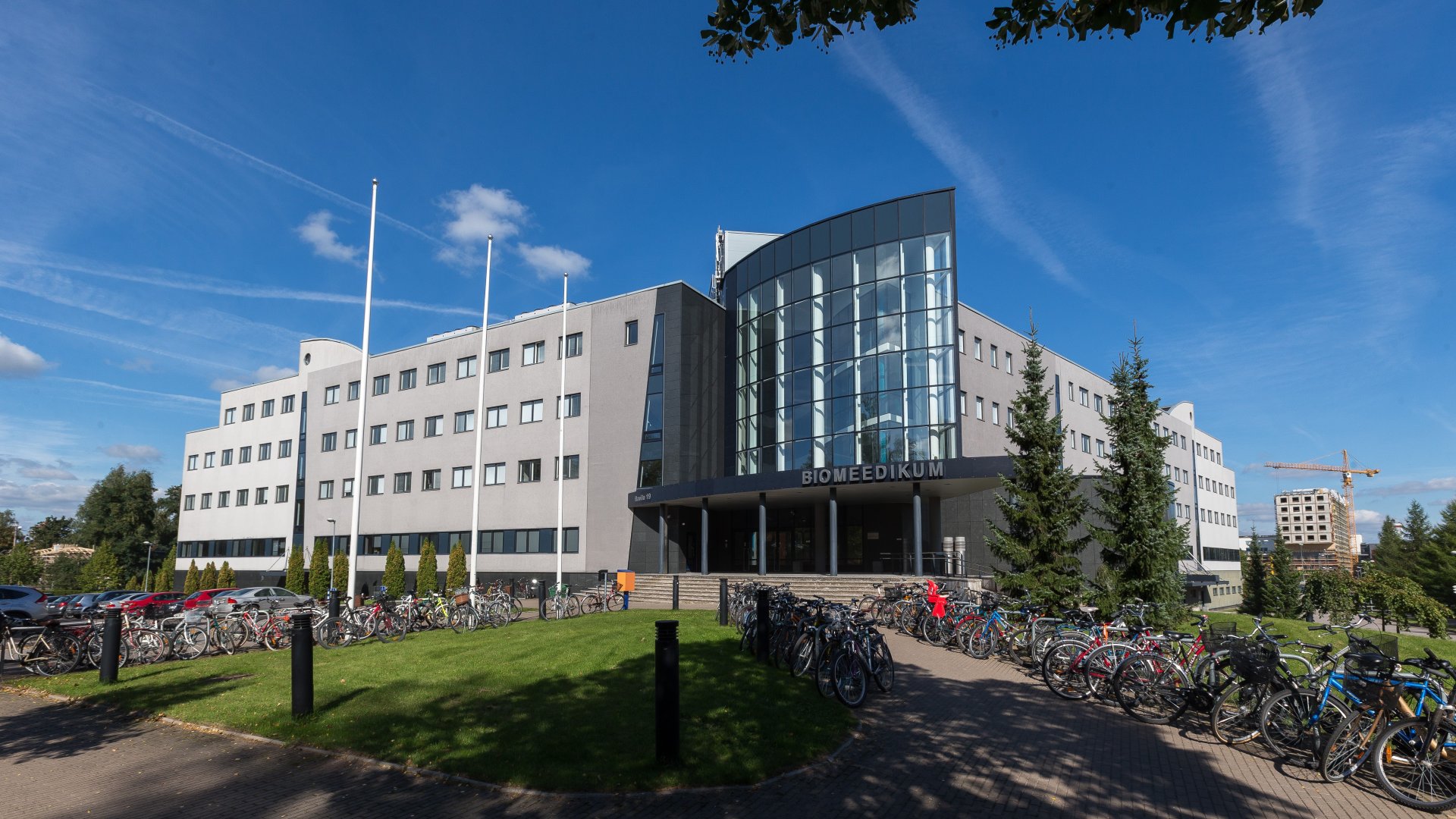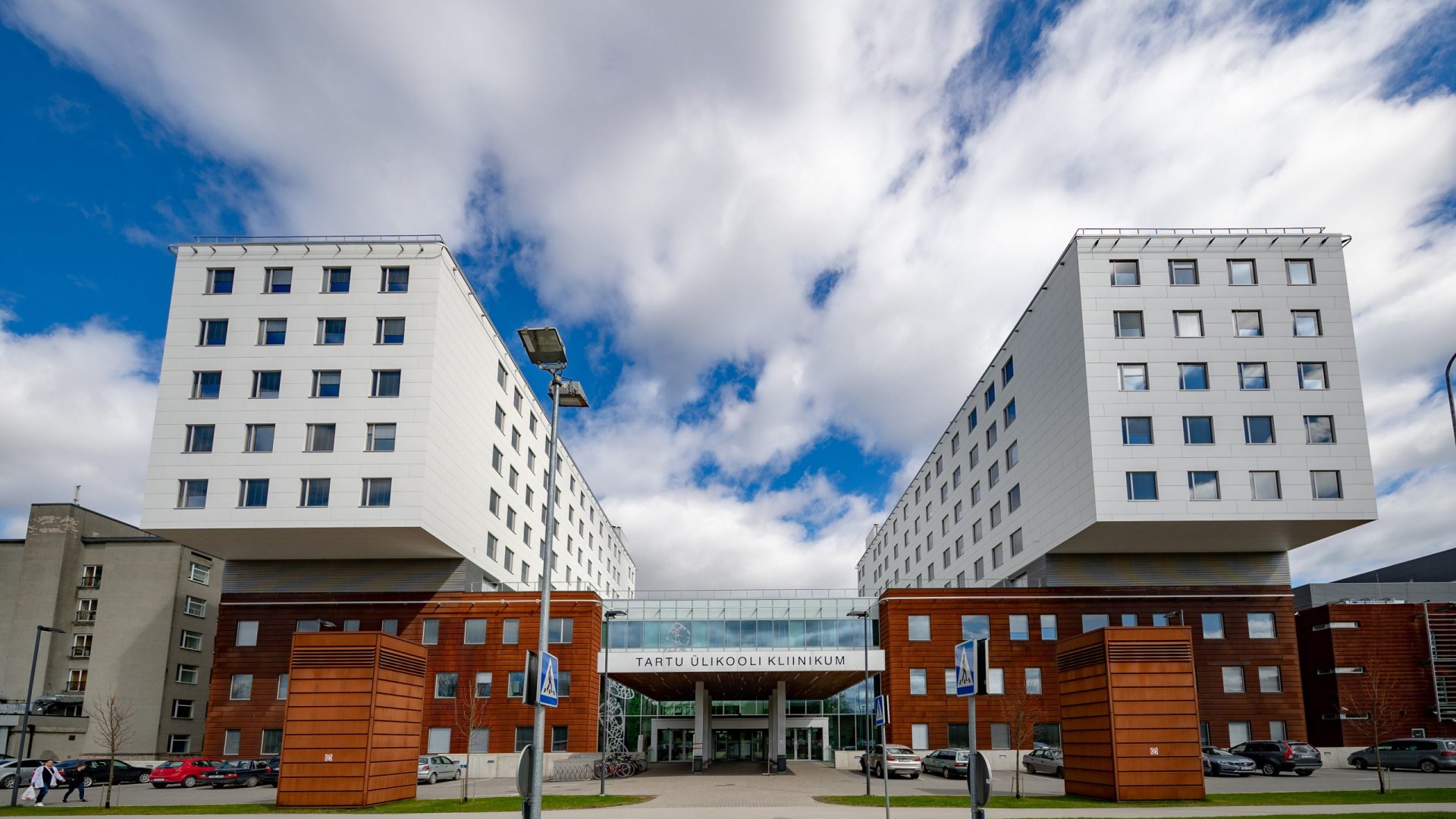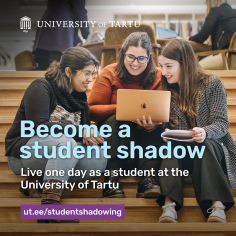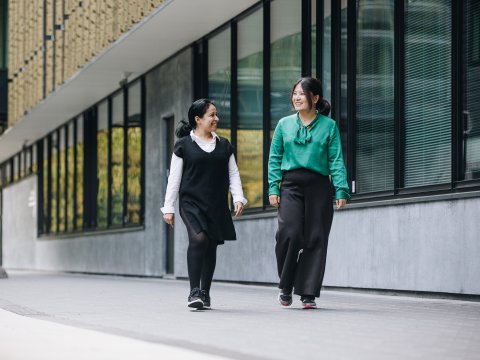Medicine
2 January
15 April
25 May
2 September
- The University of Tartu belongs to the top 350 universities in the world (see Rankings and Surveys).
- You will work with actual patients in Estonia's largest medical care provider, Tartu University Hospital.
- You will learn the Estonian language to work in local hospitals.
- After graduation, you can work as a doctor, enter postgraduate specialist medical training or continue studying at the doctoral level.
- 99% of Estonian doctors have graduated from the University of Tartu.
- The university belongs to the top 1% of the world's most-cited universities and scientific institutions in Clinical Medicine (ESI 2023).
The six-year programme in Medicine is designed to teach students the core competencies required to become highly skilled doctors. The general objective of the Medicine programme is to train physicians who:
- can provide medical assistance of high-quality corresponding to recent achievements in medicine and high ethical standards;
- enhance the awareness of society of the importance of measures of health promotion and disease prevention;
- wish to contribute by their activities to the development of medicine as a field as well as medical science;
- are willing to engage in self-education during their entire professional career.
It is a "hands-on" programme: students get a lot of practical training at the Tartu University Hospital, Estonia's largest medical care provider. It is the only medical institution in Estonia with specialists at such a high level in several fields.
Learning outcomes
A student who has completed the curriculum:
- has systemic and comprehensive knowledge of the concepts, theoretical principles and research methods used in medicine;
- has an attitude appropriate to the medical profession, sufficient professional knowledge and skills, and clinical experience;
- is familiar with and follows the ethics of science and medicine and the principles of evidence-based medicine;
- can provide qualified medical help, which is in line with the most recent medical achievements, to those in need;
- can pass on medical knowledge and conclusions based on such knowledge to patients, colleagues, and the general community;
- can work in a position that requires a doctor's qualification;
- is qualified to continue studies in specialised medicine or a doctoral programme;
- acknowledges the need to continue improving their knowledge and skills in medicine during their professional career with the help of in-service training;
- has sufficient knowledge and skills for scientific research in the field of medicine.
Extracurricular activities
Finnish students can join TASLO, a local organisation uniting Finnish medical students.
Programme highlights in video
- Watch the presentation about International bachelor's admissions by the International Admissions Coordinator during Virtual Open Day 2024.
- Watch a presentation about the Medicine programme given at the Open Doors Day 2023.
- Watch programme representatives talk about the Medicine programme during the Online Open Doors Day 2022.
To be able to communicate with local patients, some knowledge of the Estonian language is required as well. A limited number of Estonian courses are a compulsory part of the curriculum. Still, students should also put additional effort into learning Estonian (passing the required courses alone might not be sufficient).
Students will receive a Degree in Medicine (MD) degree upon completing the programme.
Course and module details
This programme structure is the latest one confirmed by the university. Next year's modules will be updated by 15 April. Significant changes to the programme will be announced in advance on this website. Check the Study Information System for the latest updates.
Faculty of Medicine
The Faculty of Medicine has been the springboard for Estonian doctors and medical researchers since the founding of the alma mater in 1632. The faculty is committed to improving the health of Estonians and beyond through studies, training for medical staff, science and social responsibility.
The Faculty of Medicine comprises six institutes: the Institute of Biomedicine and Translational Medicine, the Institute of Pharmacy, the Institute of Dentistry, the Institute of Clinical Medicine, the Institute of Family Medicine and Health and the Institute of Sport Sciences and Physiotherapy.
The alumni of the faculty make up 99% of Estonian doctors, dentists and pharmacists and the majority of renowned exercise and sports scientists, physiotherapists and sports coaches.
Read more about the Faculty of Medicine here.

Visit us virtually
Explore Tartu, the Faculty of Medicine, and the student dormitories through the university's virtual tour here.
Biomedicum tour

Tartu University Hospital is the largest healthcare provider in Estonia. High-quality tertiary medical care is offered in nearly all specialities. The hospital is the only institution to perform organ transplantations in Estonia.
Tartu University Hospital is the only academic hospital in Estonia. It plays a major role in both undergraduate and postgraduate studies in medical fields. All staff is trained to supervise students and residents from the Faculty of Medicine and nursing students and colleagues from other hospitals.
Read more about Tartu University Hospital here.
After graduation, students can pursue a wide variety of careers internationally. Students can continue their education in a residency programme in Estonia (read more here) or abroad and become doctor-specialists, study medicine at the doctoral level, or have a job requiring a medical degree.
Admission requirements for the Medicine programme
- Higher secondary education – please see our country-specific document requirements and requirements for those who are graduating in the upcoming spring/summer
- Online entrance exam in Physics and Chemistry
- English language test result
NB! Citizens of the Russian Federation who, under the legislation of the Republic of Estonia, cannot apply for a long-stay visa or residence permit to study or do not have a valid legal basis to stay in the Republic of Estonia until the end of the curriculum’s standard period of study are not eligible to apply to the University of Tartu in the 2024/2025 academic year.
According to the current legislation, citizens of Belarus can apply for Estonian long-term visa and temporary residence permit for studies and are therefore eligible to apply to the University of Tartu.
Applications are evaluated as follows:
- Online entrance exam in Physics and Chemistry (yields 60% of the final score)
- The score of the motivation letter (yields 20% of the final score)
- Entrance interview (yields 20% of the final score)
- NB! In order to be considered eligible for an entrance interview, the first 2 indicators (entrance test score and motivation letter score) must each give at least 51 points out of 100 as the maximum.
The online entrance test will take place on 08.05.2024 (between 00.00-23.59) and you will have 120 minutes for completing the test.
Physics and Chemistry Entrance Exam
Please find here a Chemistry sample exam
The admissions test for the Medicine programme will be taken online on the testid.ut.ee platform. Applicants, who have got positive score for the motivation letter (above 51%) qualify for the test. The aim of the test is to evaluate the applicant’s knowledge and skills in physics and chemistry. Eligible applicants will receive usernames and a link to the platform along with all required information via email. NB! It is the candidates’ responsibility to check email for the instruction regarding the admission test. All applicants are responsible for the quality of their internet connection. The computer must have an updated version of the web browser. If the test is interrupted for any reason, the test can be restarted and continued only until the test is closed.
The applicant has 60 minutes to answer both the chemistry and physics sections of the test.
There is a total of 120 minutes to complete both tests.
The applicant should have paper, pencil, and calculator ready to make calculations while taking the test.
Chemistry Exam
The chemistry test is based on the compulsory chemistry courses of the Estonian curriculum of upper secondary school:
1. General chemistry
- The development of chemistry as a science. Physical and chemical research methods in Chemistry. Chemistry-related career-choices.
- Structure of matter. Modern understanding of the structure of atom. Information in the periodic table and interpreting it. Types of chemical bonds. Hydrogen bond. Intermolecular forces. The relationship between the physical properties of a matter and the structure of a matter.
- Why and how do chemical reactions occur? Reaction activation energy, active collisions. Exothermic and endothermic reactions. The rate of a chemical reaction and factors influencing the reaction rate. Chemical equilibrium and its shifting (the Le Chatelier principle).
- Dissolution process, chemical reactions in solutions. Dissolution process of substances. Electrolytes and non-electrolytes; strong and weak electrolytes. Protolytic theory of acids and bases. Molar concentration. Interionic reactions in solutions, the conditions of their course. pH. Environment (pH) in the solution of a hydrolysing salt.
2. Inorganic chemistry
- Metals. Overview of the characteristic physical and chemical properties of metals. Comparison of the chemical activity of metals; activity series of metals. Metals and their compounds in everyday life and nature. Redox processes related to metals: producing metals from ore, electrolysis, corrosion, galvanic cells (without requiring reaction equations). Taking into account reaction yield and additivities in molar calculations based on a reaction equation.
- Non-metals. Overview of the physical and chemical properties of non-metals depending on the position of the element in the periodic table. Comparison of the chemical activity of non-metals. Overview of some non-metals and their compounds (chosen freely, on the example of natural and/or industrial processes).
3. Organic chemistry
- Hydrocarbons and their derivates. Structure of carbon compounds and the ways of describing it. Alkanes, nomenclature principles, isomerism. Dependence of physical properties of substituted alkanes (halogen compounds, alcohols, primary amines) on their structure. Comparison of the chemical properties of unsaturated and aromatic hydrocarbons and alkanes. Chain-growth polymerisation. Hydrocarbons and their derivates in nature and industry.
- Organic substances around us. Aldehydes as the oxidation products of alcohols. Substituted carboxylic acids (amino acids, hydroxy acids) and functional derivates of carboxylic acids (esters, amides). Polycondensation. Organic compounds in living organisms: fats, saccharides, proteins.
The chemistry test contains different types of questions and tasks. The applicants can use the periodic table, activity series of metals and the solubility table (the applicant can use them in the test environment).
• Chemistry curriculum (courses: „Fundamentals of Chemistry“, „Inorganic substances“ ja „ Organic compounds “)
Physics Exam
- Mechanics. Distance, position and displacement. Velocity and acceleration, equations for motion. Time dependences of velocity and covered distance, corresponding graphs. Newton’s laws. Mass and density. Addition of forces. Net force. Linear momentum, conservation of momentum. Reactive motion. Newton’s Law of gravitation. Gravitational acceleration, weight of a body, normal force. Elasticity and the Hooke’s law. Frictional force, friction coefficient. Work and power. Kinetic and potential energy. Conversions of energy. Pressure. Pascal and Archimedes principles. SI units of all mentioned quantities. SI prefixes. Conversion of units. Rotation, orbital motion and vibration. Angle, period, frequency, angular and linear velocity, centripetal acceleration. Parameters of oscillation: deviation, amplitude, period, angular frequency and phase. Sound waves in air. Wavelength, velocity, period and frequency. Reflection, refraction, interference and diffraction of waves.
- Electric charge and current. Elementary charge. Coulomb’s law. Electric field E, potential and voltage. Magnetic fields of permanent magnet and current-carrying wire. Ampere’s force. Magnetic induction B. Electric and magnetic field lines, superposition principle. Lorentz force. Electromagnetic induction. Electromotive force (EMF). Magnetic flux. Faraday’s law of induction. Lenz’s law. Self-induction in the coil. Capacitance and inductance. Energies of electric and magnetic fields. Oscillating circuit and antenna. Generation of electromagnetic waves. Electromagnetic spectrum. Radio waves and microwaves, infrared, visible and ultraviolet lights, x-rays and gamma rays. Wavelength, frequency and photon energy (in eV). Wave-particle duality of light. Diffraction, interference, reflexion and refraction of the light. Refractive index and the speed of light. Convex and concave mirrors and lenses, types of images. Optical power of the lens. Dispersion of light. Spectral analysis. Polarised light and its applications. Thermal radiation and luminescence. Ohm’s law. Resistance and resistivity. EMF and intrinsic resistance of the source. Electrical power. Conductivity of liquids, gases and semiconductors, p-n junction. Light emitting diodes and solar cells. Alternating current. Transformers and transmission lines. Electrical safety. SI units of electric and magnetic physical quantities. Conversion of units.
- Temperature and heat. Celsius and Kelvin temperature scales. Ideal gas. Equation of state for the ideal gas. Absolute temperature and the average kinetic energy of molecules. Work in thermodynamics and the heat transfer. Amount of heat and internal energy. First principle of thermodynamics. Isothermal, isobaric, isochoric and adiabatic processes. Operation principle of a heat engine, its efficiency. Second principle of thermodynamics. Reversible and non-reversible processes and the entropy. Energy transfer in nature and technology. Energetics and the energy resources. Gaseous, liquid and solid states of matter. Phase transitions and the latent heat. Molecular forces and the real gas. Water vapour in air. Absolute and relative humidity, saturated vapour and dew point. Weather phenomena. Surface tension and wetting.
- Atomic and nuclear physics. Photoelectric effect. Models of the atom. Matter waves. Main ideas of quantum mechanics. Electron diffraction. Heisenberg uncertainty principle. Quantum numbers. Emission and absorption of the light by an atom. Nuclear forces, protons and neutrons. Mass defect. Nuclear binding energy. Equivalence of mass and energy. Nuclear reactions. Nuclear energetics and nuclear weapons. Radioactivity. Half-life. Radioactive dating. Types of ionising radiation. Radiation safety.
Scoring System
The physics and chemistry entrance exam is evaluated in a 100-point scale. It is possible to get up to 50 points for the chemistry test and 50 points for the physics test as well. The exam has been passed if the exam result is at least 51 points. The points of the entrance exam in physics and chemistry make up 60% of the total score of the candidate's entrance exams.
No feedback is provided right after the completion of the test. The applicant will be informed about the exam result via email.
The motivation letter is a part of the online application form. Guidelines and evaluation criteria for the motivation letter are also included in the online application form.
Please write a brief motivation letter (in English, maximum of 4000 characters with spaces) based on the following points:
- Please explain why do you apply for the MD program at the University of Tartu, Estonia, instead of studying medicine in your home country/elsewhere in the world;
- Describe how your previous education, work history and personality make you especially capable of facing the challenges of studying medicine.
- Please point out how many courses of chemistry and biology you have taken at secondary school. Please indicate what was the minimum and maximum number of courses offered in these two subjects. Also, bring out what branches of chemistry you have studied. If you have studied biology, chemistry at university /college level, please briefly describe the content of studies.
- Describe the strategies you will use to deal with the challenges of studying in a cultural environment different from your home country;
- What do you plan to do after completing your MD?
In evaluation, the following criteria will be considered:
- Fluency of written English (30%);
- Motivation, analytical and argumentation skills (70%).
The maximum score for motivation letter is 100 points and the result is positive only if the applicant gains 51 points or more.
The purpose of the entrance interview is to find out the student candidate:
- motivation to study in the chosen field and ability to self-analyze;
- motivation to come to study in Estonia and awareness of the local learning environment;
- self-expression and English language skills.
The structure of the entrance interview:
1. Introduction of the interviewee and members of the committee (1-2 min);
2. questions of the members of the committee to find out the motivation, self-analysis ability and readiness of the student candidate for team work (8-9 min)
Grading scheme:
- motivation to study in the chosen field and the ability to self-analyze (up to 50 points);
- motivation to come to study in Estonia and awareness of the local learning environment (25 points)
- Self-expression skills and English language skills (up to 25 points).
Development of the grade:
Each member of the committee evaluates the candidate during the interview on the basis of the above five criteria. The overall grade is the average of the scores of the members of the examination committee.
The maximum score of the examination result is 100. The minimum positive result required for application is 66 points.
Calculating final admissions score: Admission for Medicine programme takes place on the basis of a ranking list. When ranking applicants, the BMAT score (70%), motivation letter (15%) and entrance interview (15%) are taken into account
The entrance interview will take place between 13.05-20.05.2024.
For further information on assessing candidates´ academic performance and calculating admissions´ score see here.
How to apply
NB! Estonian applicants should apply via National Admission Information Systems (SAIS). Further information in Estonian is available here.
The following information applies to international students and Estonian students who graduated abroad:
Application system opens on 2 January and closes on 15 April. The following documents must be electronically submitted via DreamApply by 15 April:
- online application
- motivation letter - The motivation letter is a part of the application form, and cannot be sent separately. Guidelines and evaluation criteria for the motivation letter are also included in the online application form;
- official certified copy of the secondary school certificate and grade list in the original language (must include description of the grading scale).
You can apply with current grades, if you are graduating in one of the member countries of EU, EEA or OECD, one of the member countries of CIS (Russia, Armenia, Azerbaijan, Belarus, Kazakhstan, Kyrgystan,Tajikistan, Uzbekistan), in Ukraine, Georgia or Moldova or if you are graduating from an IB Diploma programme or with a General Certificate of Education with A-level exams.
Applicants from these countries and programmes who are graduating in the upcoming spring/summer and having their graduation documents issued later than the application deadline should electronically submit their most recent grade sheet or transcript with results for all higher secondary school years (including grades/results for the last autumn semester) by the application deadline, 15 April. The grade sheet or transcript should be supplemented by an official statement from the issuing school or university indicating current enrollment and expected graduation date. Admitted candidates are required to post the certified copies of their graduation documents as soon as these have been issued. NB! Please note that certified copies and translations (if applicable) of your final official graduation documents must reach us by the end of July at the latest.
NB! Applicants from other countries can only apply if they have already obtained their final graduation documents and can submit these by the application deadline, 15 April. - certified translations of the secondary school certificate and grade list into English;
- copy of the passport page stating the applicant´s personal particulars;
- English language proof: https://ut.ee/en/english-language-requirements
- confirmation/receipt of application fee payment (if applicable). All international applicants are required to pay the application fee EUR 100, unless they have completed the previous study level in Estonia. An application will only be processed after the fee has been received by the UT.
Important information for Finnish applicants: Regarding secondary education documents, applicants from Finland must submit an officially certified copy of the upper secondary school leaving certificate (Lukion päästötodistus) and of the matriculation examination certificate in Finnish, also certified translations of both documents into English. For further information please see our country-specific document requirements for Finland.
Submitted applications (also motivation letters) can not be edited! It is only possible to upload new documents (e.g. graduation certificates). Applicants will receive feedback and notifications through the DreamApply system to their e-mail. Incomplete applications or those submitted by e-mail will not be considered for admission.
The evaluation of applications will be made based on the electronic copies added to DreamApply. A general ranking list will be formed based on the electronically submitted applications and admission results (including offers) will be announced to all applicants personally via DreamApply by 25 May at the latest. Admitted candidates are expected to accept or decline the offer in DreamApply in 7 days. If the decision is not communicated to UT via DreamApply by the stipulated deadline, UT reserves the right to withdraw the admission offer.
NB! It is not possible to postpone/defer the beginning of studies to the next academic year.
Terms and conditions of the admission offer
Admission offers are conditional. This means that there are conditions in the offer which the applicant needs to fulfil in order to be admitted (e.g. sending application documents by post; obtaining the required level of education). If the conditions are not met, UT has the right to withdraw the offer. Also, UT reserves the right to withdraw or amend any offer or revoke the matriculation of a student, if it becomes evident that the application contains fraudulent information, the qualification does not provide access to the chosen study programme or the student is found to have omitted key information from the application. Should such circumstances occur, UT will not be liable for any material or immaterial loss which the student may suffer as a result.
Once the admission results have been announced, all admitted students are required to send the application documents by post to: Student Admissions, University of Tartu, Ülikooli 18-133, Tartu 50090, ESTONIA.
The documents are expected to be mailed only by those receiving the admission offer (unless instructed otherwise by the Admissions staff). The documents must reach the university within 3 weeks from the announcement of the offer. If the application documents do not reach the UT Student Amdissions by the deadline, UT has the right to withdraw the admission offer. Applicants will be informed via DreamApply when their documents have arrived.
NB! If you applied last year as well and already sent the required documents by post, it might not be necessary to resubmit all documents by post this year. Please contact the Student Admissions (admissions@ut.ee) for details.
Requirements for educational documents
All copies of educational documents (secondary school certificate and grade list/transcript) must be officially certified. By certified we mean that the copies should bear an original signature and seal of the authority certifying that these are true copies of the original document(s). The copies can be certified either 1) by an authorised official of the issuing institution, or 2) by a notary, or 3) with an Apostille attached. NB! Country-specific requirements may specify the way documents from certain countries must be certified.
Please note that UT does not accept simple copies made on the basis of already certified copies (primary copies are needed).
All admitted students are required to present their original qualification certificates upon arrival (unless these were sent directly from the issuing institution).
Paying the tuition fee
• EU/EEA/Swiss citizens are required to pay the fee for the first semester once they arrive in Tartu (by 20 September at the latest after signing the fee contract, please read more here).
• Admitted students from other countries are required to pre-pay half of the first semester's tuition fee. The invoice along with the pre-payment deadline and payment details will be sent to applicants via DreamApply after they have accepted the admissions offer and the University has received the hard copies of the application documents. Second part of the fee is due on 20 September. NB! The official admission letter (necessary for visa application) will only be issued once the University of Tartu has received the pre-payment.
NB! By transferring the pre-payment to the university, you confirm that you have informed yourself about the process of the visa and temporary residence permit application and you are able to arrive in Estonia by the start of the academic year. If you have any questions please contact studentvisasupport@ut.ee.
The official admission letter will be sent to admitted students electronically via DreamApply only after the admissions office has received and reviewed hard copies of the application documents, and received the tuition fee pre-payment (if a pre-payment was required, please see step 3 for more details).
NB! The electronic admission letter is also sufficient for non-EU students for applying for visa/residence permit in Estonian embassies.
Once the admission letter is issued, accepted students may proceed further with arranging their arrival. All non-EU students should first consult information on the process of visa and temporary residence permit application to be sure, as where and when the relevant documents need to be applied. Note that housing at the UT dormitories can be applied during a limited period of time, unless specified otherwise on the website. For housing alternatives please find further information on Tartu Welcome Centre website.
NB! Admitted students who are not citizens of an EU or EEA country or Switzerland need to make sure they obtain the Estonian long-term visa on time in order to be able to participate in the orientation programme for international students held in the last week of August. They are also required to visit the Admissions Office in person to complete their arrival registration by September 2, 2024, at the latest. Failure to do so will result in the revocation of their admission decision and visa.
Travel information can be found here.
Based upon common queries, the most important information has been summarised into a pre-arrival information website UT Getting Started.
Estonian applicants should apply via National Admission Information Systems (SAIS). Further information in Estonian is available here.
UT has a course system, which means that in order to take courses from second or higher year, the student must successfully finish all the courses from previous year(s). Due to differences in educational systems and curricula, it is very unlikely that an applicant from another university could transfer all required courses from the previous year(s) and therefore the Faculty of Medicine does not accept transfer students.
If you are interested in studying at UT, please apply for admission to start as a first year student. If admitted, it might be possible to transfer some courses and credits.





